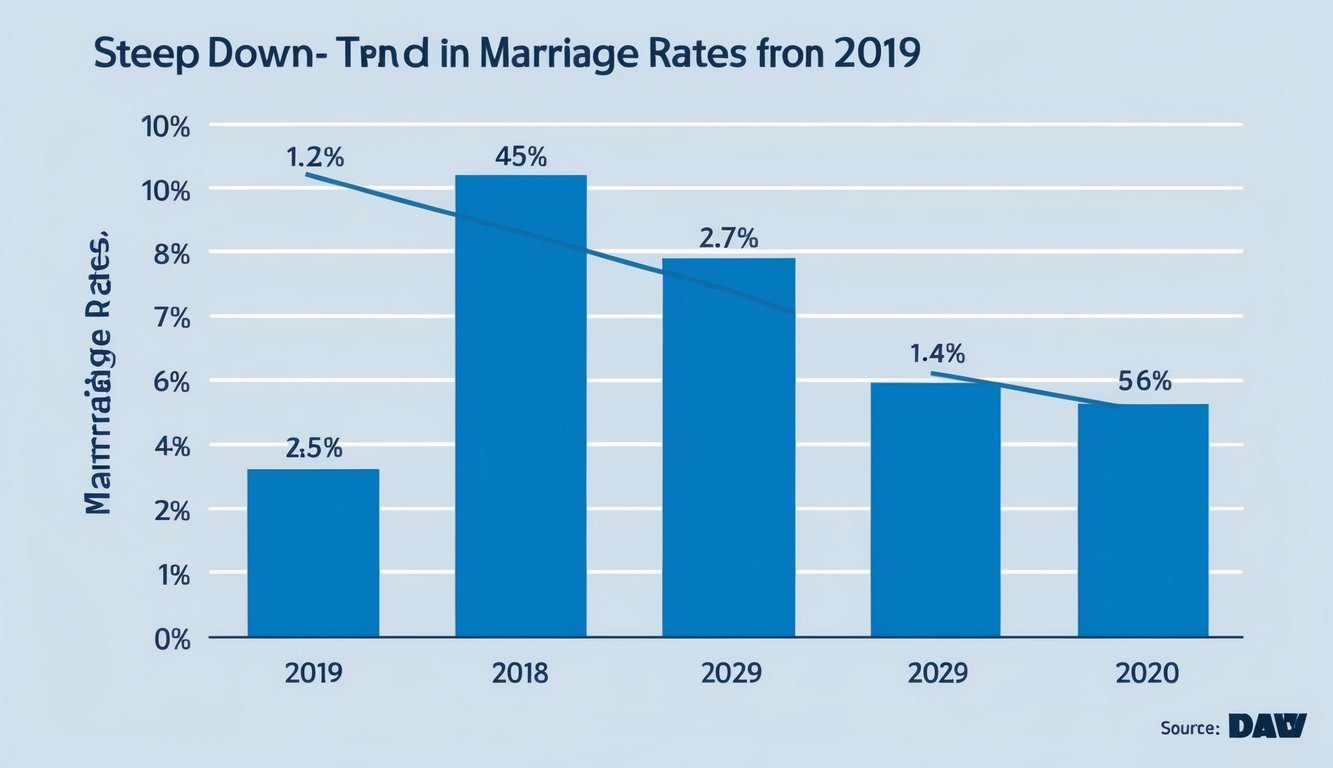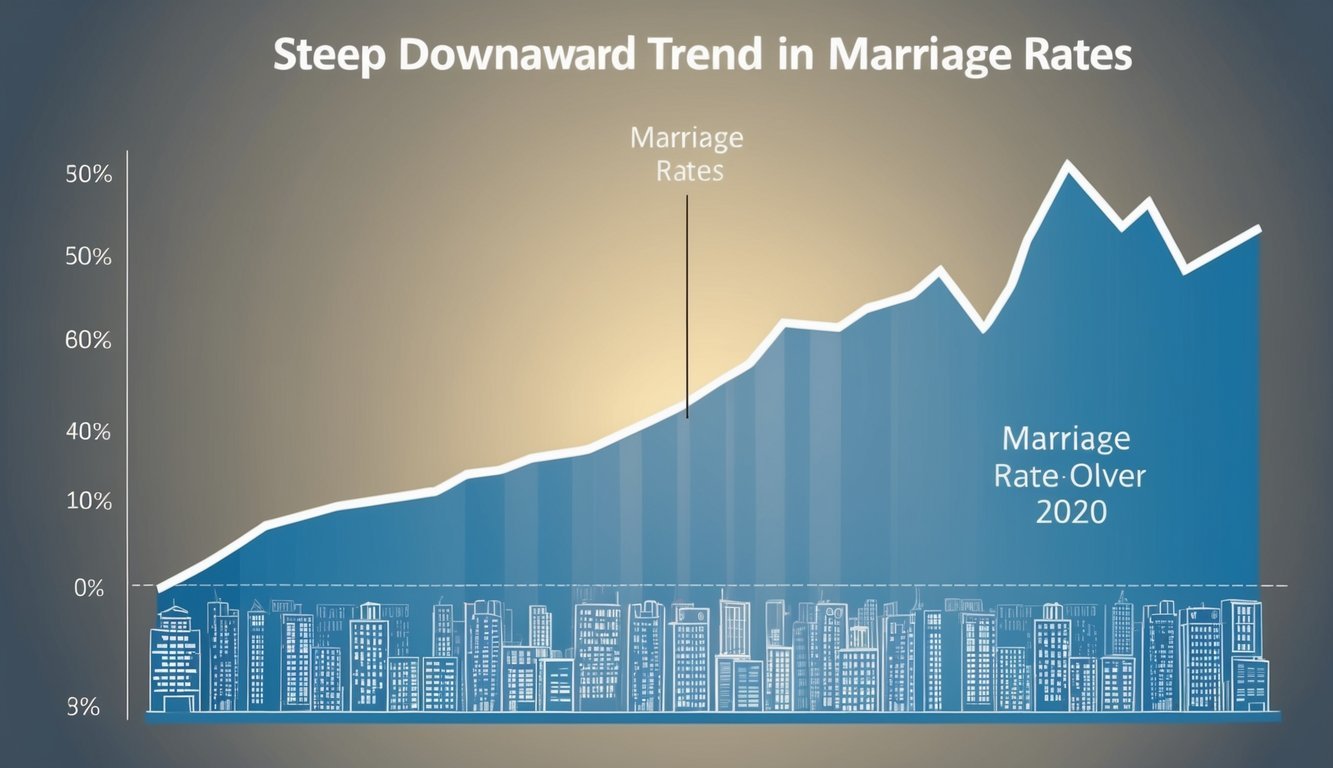PsychNewsDaily Publishers
100 Summit Drive
Burlington, MA, 01803
Telephone: (320) 349-2484
PsychNewsDaily Publishers
100 Summit Drive
Burlington, MA, 01803
Telephone: (320) 349-2484
Marriage rates in the United States dropped by 16.8% in 2020 due to the COVID-19 pandemic, reflecting changing societal attitudes and economic uncertainties.

In recent years, marriage rates in the United States have seen significant changes, particularly during the COVID-19 pandemic. A new study reveals that the marriage rate plummeted in 2020, dropping by 16.8% compared to the previous year. This decline reflects not only the impact of lockdowns and social distancing measures but also changing attitudes toward marriage in society.
Many couples faced uncertainties during 2020, which may have led to hesitations about tying the knot. The initial data indicates that this drop in marriage licenses was felt nationwide, with some states reporting declines as high as 18%.
As people navigated the challenges brought by the pandemic, the traditional path to marriage seemed less accessible and more complicated.
Exploring the reasons behind this decrease can shed light on how the pandemic has reshaped relationships and societal norms. Understanding these trends is essential for recognizing the evolving landscape of love and commitment in America.

The U.S. marriage rate has experienced a notable decline in recent years. According to the American Community Survey, this trend became more pronounced during the COVID-19 pandemic.
In 2020, many couples postponed or canceled their weddings due to safety concerns. The Centers for Disease Control and Prevention reported restrictions on gatherings that greatly impacted marriage ceremonies.
Here are some key statistics about the decline:
The National Center for Health Statistics and National Vital Statistics also noted how factors like economic uncertainty affected the decisions to marry. Many people opted to wait longer before tying the knot.
Cultural shifts may also contribute to this decline, as some individuals prioritize education and careers over early marriage.
While the marriage rate fell during the pandemic, it saw a rebound in 2022, returning to pre-pandemic levels. This suggests that many couples still value marriage, even in changing times.

Marriage trends in the U.S. show variations based on race, education, and age. Each demographic group has different experiences and patterns when it comes to marriage rates. Understanding these patterns helps highlight the broader social changes affecting marriage.
Marriage rates differ significantly among various racial and ethnic groups. For example, in 2020, Black Americans had the lowest marriage rates, which reflect ongoing social and economic challenges. Conversely, Asian Americans often have higher marriage rates due to cultural values that prioritize family.
In 2021, research indicated that Asian women had a marriage rate of 30.4 per 1,000 unmarried women. In comparison, the rates for Hispanic and White women were 20.1 and 17.3, respectively. This data underscores how different cultural backgrounds influence marriage decisions.
Education plays a crucial role in marriage trends. Individuals with higher education levels tend to marry later in life compared to those with less education.
For instance, women with college degrees often marry at an average age of 30, while those without degrees marry earlier, sometimes before age 25.
Additionally, data shows that the marriage rate for college-educated women is roughly 26% higher than for those without a high school diploma. Educational attainment impacts not only the timing of marriages but also the stability and longevity of those unions.
Age is another significant factor influencing marriage trends. In recent years, there has been a notable decline in marriage rates among younger people. For example, women aged 18-24 are now marrying at much lower rates—around 15% less than in the early 2000s.
Conversely, older age groups, particularly those aged 30 and above, are experiencing a rise in marriage rates. Many individuals are choosing to focus on careers and personal development before settling down. This shift reflects changing priorities and societal norms around marriage and family life.

The COVID-19 pandemic greatly influenced people’s choices about marriage. Many couples faced uncertainty during this time. Concerns about health, jobs, and finances led to changes in marital plans.
Marriage Rates:
Divorce Rates:
This decline in both marriages and divorces hints at a change in how people view relationships during tough times. Many chose to postpone weddings until they felt more secure.
Shifts in Marital Patterns:
As the pandemic progressed, the landscape of marriage started to shift again. By 2022, marriage rates increased to 6.2 per 1,000 people, the highest level since 2018. This suggests that once stability returned, many felt ready to commit.
People now think more carefully about their marital status. The pandemic has changed how they view commitment and timing in their relationships. As life continues to stabilize, ongoing trends in marriage and divorce might evolve further.

Many factors contributed to the decline in U.S. marriage rates during 2020. Changes in societal trends, economic conditions, and the impact of the COVID-19 pandemic all played a significant role. Here are some common questions that explore the reasons and effects of this decline.
Several reasons influenced the drop in marriage rates in 2020. The COVID-19 pandemic led to restrictions on gatherings, which made many couples postpone or cancel their weddings. Financial uncertainty also caused individuals to reconsider their plans for marriage.
Marriage rates in the U.S. have been gradually declining in recent years. From 2011 to 2021, the marriage rate decreased from 16.3 to 14.9 marriages per 1,000 women. This trend continued into 2023, showing a continued preference for delayed or smaller weddings.
Divorce rates have seen some fluctuations in recent years. While they were on the decline before the pandemic, many experts noted a stabilization during and after COVID-19. The changes in marriage rates may have indirectly influenced these divorce trends.
In the past decade, marriage rates have generally decreased while divorce rates have also shown a slight decline. The marriage rate in 2021 was about 14.9 per 1,000 women. This compares to a divorce rate that has also seen a drop, indicating changing societal norms.
More adults are choosing to remain single than in previous generations. Recent surveys suggest that a higher percentage of American adults prioritize personal goals or career paths over marriage. This trend reflects a shifting attitude towards traditional relationships and commitments.
The marriage rate in 2020 was notably lower than in previous years. Data indicated an 18% drop in marriage licenses issued in several states compared to earlier years. This decline highlights the significant impact of events like the pandemic on personal decisions.